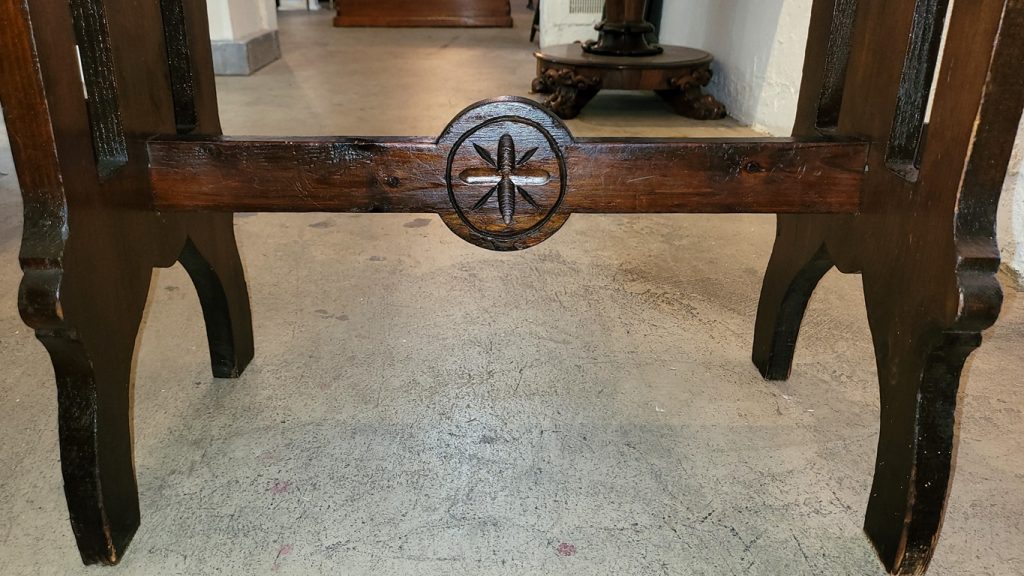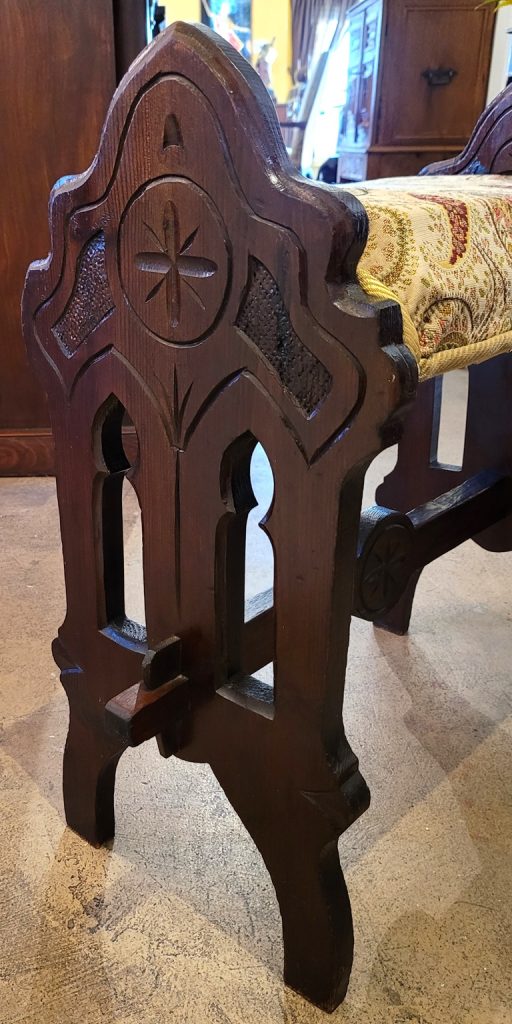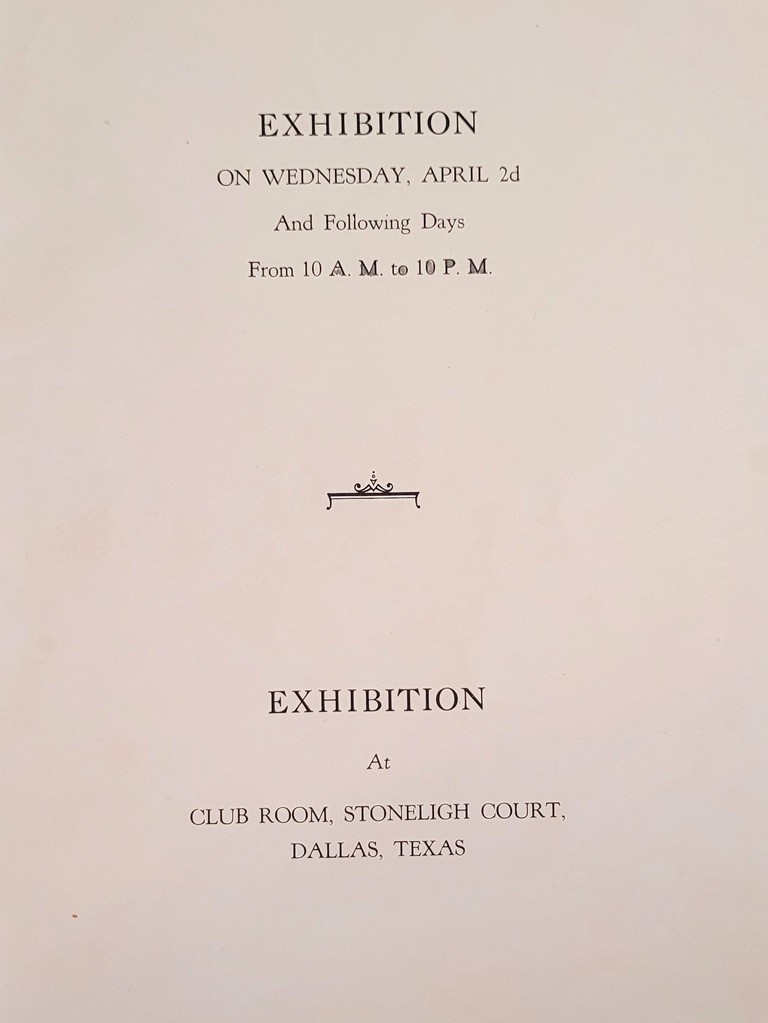PRESENTING A LOVELY 19C French Gothic Revival Bench/Stool or Organ Stool/Bench seat.
Made in rural/provincial France (possibly Brittany) circa 1860-80 and in the Gothic Revival Style.
We are of the opinion that the wood is ‘chestnut’ and not ‘oak’, as one would expect.
The use of ‘chestnut’ makes this even RARER!
Very ‘ecclesiastical’ in design and possibly would have been made for a Church, as the organ player’s stool/bench seat.
Oblong/rectangular in shape.
Unmistakably French, due to the base cross support design and construction, with circular central medallion (very ‘Breton’ in design) and wooden peg inserts for securing the base cross support on the outside of each side.
This bench/stool is ‘nicer’ than most that have appeared on the market, due to it’s very good condition and the beautifully hand-carved decoration, beveled edges and raised arches on both sides. Also, the pair of carved gothic window-esque friezes on both sides, are a lovely touch!
We are confident that this is a 19th Century piece, due to its natural aging, patina and when being re-upholstered it still had it’s original straw and horse (?) hair filling for the seat cushion.
This Bench is part of an EXCEPTIONAL Private Dallas Collection.
This Bench has IMPECCABLE PROVENANCE:
It was purchased by an ancestor of the family (together with several other items also in the Collection), at a French Antique Auction held at the Club Room in the Stoneleigh Court (Hotel), Dallas on Wednesday the 2nd April 1930. (Now The Meridian Hotel).
We have the Original Auction Catalog, which has remained with the Collection, since that Auction. (see photos).
The Auction was titled: ” Works of Art and Furnishings of The Chateau de Turique (Nancy) and The Conde-Rougemont Home (Touraine). The cover of the Catalog also has a ‘seal’ of a Coat of Arms.
The first page of the Catalog States: “Exhibition on Wednesday, April 2nd And Following Days From 10 A.M. to 10 P.M……EXHIBITION at CLUB ROOM, STONELIGH COURT, DALLAS, TEXAS”.
The Second page gives a brief description of the Auction contents and states that ” This Exhibition will be presented by M. Fernand M. Adda of Paris France”
This bench, we believe, was Lot No: 297 and was described in the Auction Catalog as:
297 – CARVED GOTHIC BENCH “Oblong, supported on solid ends. Frieze pierced with Gothic traceries” …. XV Century”
It is noted on the margin by the buyer, that they paid the princely sum of $90 (hammer price not including commission) in 1930, for this piece. Allowing for simple inflation, this would equate to over $1,650 today.
We are of the opinion, that Monsieur Adda, was incorrect in his ‘dating’ of this piece (amongst others in the auction LOL)! He catalogued it as 15th Century, BUT a close examination tells us that it is much later … mid to late 19th Century, in our opinion! It simply does not exhibit the natural aging of a 600 year old wooden piece.
If this were a 15th Century piece, is would be much, much more valuable today, BUT we have appraised it, based upon a 19th Century value for such a quality item.
The stool has been freshly re-upholstered with a beautiful high quality ‘paisley pattern’ silk fabric, with greens, golds, pink and burgundy red elements. It has had a foam cushion inserted under the fabric, to make it more comfortable for daily usage. It is edged with a golden rope trim.
We removed the hair from the seat cushion as it was badly decomposed and dusty but we kept the original straw base.
Gothic Revival (also referred to as Victorian Gothic or neo-Gothic) is an architectural movement that after a gradual build-up beginning in the second half of the 17th century became a widespread movement in the first half of the 19th century, mostly in England. Increasingly serious and learned admirers sought to revive medieval Gothic architecture, intending to complement or even supersede the neoclassical styles prevalent at the time. Gothic Revival draws upon features of medieval examples, including decorative patterns, finials, lancet windows, and hood moulds. By the middle of the 19th century, Gothic Revival had become the pre-eminent architectural style in the Western world, only to begin to fall out of fashion in the 1880s and early 1890s.
The Gothic Revival movement’s roots are intertwined with philosophical movements associated with Catholicism and a re-awakening of high church or Anglo-Catholic belief concerned by the growth of religious nonconformism. The “Anglo-Catholic” tradition of religious belief and style became known for its intrinsic appeal in the third quarter of the 19th century. Gothic Revival architecture varied considerably in its faithfulness to both the ornamental styles and construction principles of its medieval ideal, sometimes amounting to little more than pointed window frames and touches of neo-Gothic decoration on buildings otherwise created on wholly 19th-century plans, using contemporary materials and construction methods; most notably, this involved the use of iron and, after the 1880s, steel in ways never seen in medieval exemplars.
Throughout France in the 16th and 17th centuries, churches such as St-Eustache (1532–1640, façade 1754) in Paris and Orléans Cathedral (1601–1829) continued to be built following Gothic principles (structure of the buildings, application of tracery) with some little changes like the use of round arches instead of pointed arches and the application of some Classical details, until the arrival of Baroque architecture.
Even in Central Europe of the late 17th and 18th centuries, where Baroque dominated, some architects used elements of the Gothic style. The most important example is Jan Santini Aichel, whose Pilgrimage Church of Saint John of Nepomuk in Žďár nad Sázavou, Czech Republic, represents a peculiar and creative synthesis of Baroque and Gothic. An example of another and less striking use of the Gothic style in the time is the Basilica of Our Lady of Hungary in Márianosztra, Hungary, whose choir (adjacent to a Baroque nave) was long considered authentically Gothic, because the 18th-century architect used medieval shapes to emphasize the continuity of the monastic community with its 14th-century founders.
During the Bourbon Restoration in France (1814–1830) and the Louis-Philippe period (1830–1848), Gothic Revival motifs start to appear, together with revivals of the Renaissance and of Rococo. During these two periods, the vogue for medieval things led craftsmen to adopt Gothic decorative motifs in their work, such as bell turrets, lancet arches, trefoils, Gothic tracery and rose windows. This style was also known as “Cathedral style” (“À la catédrale”).
Link: https://en.wikipedia.org/wiki/Gothic_Revival_architecture
19C French Gothic Revival Bench/Stool.
Provenance: See full listing.
Dimensions: 23.5 inches tall, 25 inches wide, 11.25 inches deep
Seat Height of 20.25 inches.
Internal seat width of 17 inches
Condition: Very good original condition. One repaired crack, to one side panel, but not noticeable. Newly re-upholstered (see full listing).
SALE PRICE NOW: $1,800











































